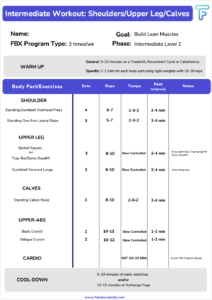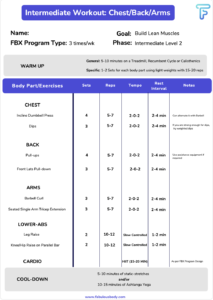What Is A Good Workout Plan?

A Good Workout Plan Will Have The Following Criteria
1) Number Of Reps
The number of reps will be limited to the range of 5—10. Ideally, it’s best to cycle between [5–7] reps and [8–10] throughout the year.
Related Article: How Many Reps To Build Muscle And Lose Fat?
2) Best Exercise Selection
70-90% of exercises will be compound in nature. Isolation exercises are also important but never the priority.
Related Articles:
The Best Exercise Selection For Every Muscle Group
Compound Exercise Vs. Isolation Exercise: Which Is Better?
3) Free Weights Like Barbells And Dumbbells Should Be Prioritized
Related Article: Free Weights Or Machines: Which Is better?
4) Ideal Frequency
I strongly believe working out 3 times a week is the ideal frequency. It’s an enjoyable and sustainable way to work out, and most importantly, it’s very effective.
Related Article: 6 Awesome Benefits Of Working Out 3 Times A Week Using Fabulous Body (FBX) Workout Routines
5) Low Volume
Although, the most important aspects of a workout routine are the exercise selection and the total weekly volume (sets*reps) you do for each muscle group per week.
For example, for a major muscle group like the chest, the weekly volume should lie between 60-120 reps per week. Now, 60-120 reps is also a huge range, and that’s where periodization will come into the picture.
You guessed it right!
As a beginner, you will start with a low volume and move up on the volume continuum as you progress into becoming an intermediate and then finally an advanced trainee.
Related Article: Weight Training Volume: How Many Reps Per Muscle Group Per Week?
So let’s say you are intermediate and do 90 reps for chest muscle each week. So it will make little difference whether you do these 90 reps in one chest session, two or even three chest workouts a week as long as you do 90 reps.
Now, there is some science that says that training your muscle group more frequently i.e. twice or even thrice weekly, is better than training it once a week.
For example, if you do an Upper Body And Lower Body Split where you train your entire body twice a week, it will look like:
Mon– Upper Body
Tue– Lower Body
Wed– Off
Thu– Upper Body
Fri– Lower Body
Sat/Sun- Off
Then, you are training your chest muscle on Mon & Thu. So you divide 90 reps into 45 reps each session. And if you are doing a bro-split where you are on a one-body-part-a-day split, then you can do 90 reps in just a single chest session, say on Monday.
Ideally, a beginner should work out 3 times a week doing full-body workouts (comprising mainly compound exercises).
Related Article: Gym Workout Routine For Beginners
Whereas an intermediate/advanced should enter into a split workout, as the total volume for each muscle group will increase. Here is a sample FBX Intermediate workout routine:
FBX Gain Intermediate Level-2:
Workout Frequency: 3 times/week.
Workout A: Shoulders/Legs

Workout B: Chest/Back/Arms

Need all FBX workouts for all levels? Check out the free course for all FBX workouts for all levels, The FBX Training.

Skill-Based Education.
Global Recognition.
Powerful Community Building
Secure a certificate of completion in as little as a day by graduating from one of our free courses.
Get Access to Our Free Courses. No Credit Card Required.

Fabulous Body Membership
Your All-Access Pass to A Fabulous Body & A Rewarding Career
25+ Certificate Courses & Programs, All Included
15 Day Free Trial, 100% Money-Back Guarantee
About Akash Sehrawat
Akash is a creator of 25+ programs and certificate courses in which more than 200,000 students have enrolled both on Udemy and Fabulous Body's native platform. Akash is also an author of three books that can be found on Amazon. His answers on Quora have gathered more than 12 million views in less than a year.








